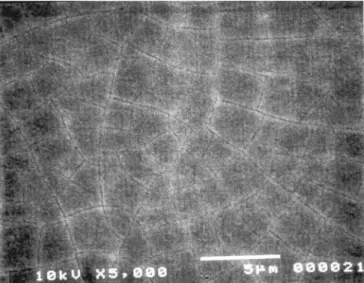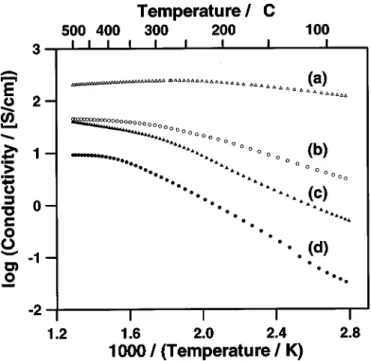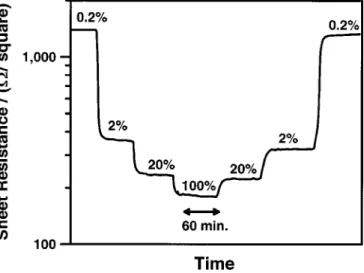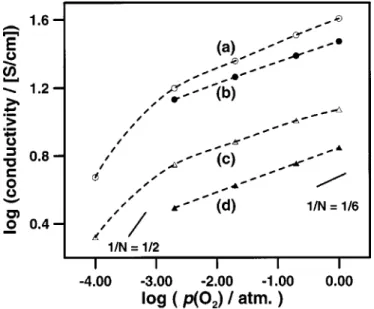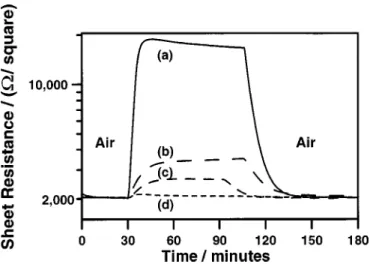Publisher’s version / Version de l'éditeur:
Journal of the Electrochemical Society, 149, 6, pp. H113-H118, 2002
READ THESE TERMS AND CONDITIONS CAREFULLY BEFORE USING THIS WEBSITE. https://nrc-publications.canada.ca/eng/copyright
Vous avez des questions? Nous pouvons vous aider. Pour communiquer directement avec un auteur, consultez la première page de la revue dans laquelle son article a été publié afin de trouver ses coordonnées. Si vous n’arrivez pas à les repérer, communiquez avec nous à PublicationsArchive-ArchivesPublications@nrc-cnrc.gc.ca.
Questions? Contact the NRC Publications Archive team at
PublicationsArchive-ArchivesPublications@nrc-cnrc.gc.ca. If you wish to email the authors directly, please see the first page of the publication for their contact information.
NRC Publications Archive
Archives des publications du CNRC
This publication could be one of several versions: author’s original, accepted manuscript or the publisher’s version. / La version de cette publication peut être l’une des suivantes : la version prépublication de l’auteur, la version acceptée du manuscrit ou la version de l’éditeur.
For the publisher’s version, please access the DOI link below./ Pour consulter la version de l’éditeur, utilisez le lien DOI ci-dessous.
https://doi.org/10.1149/1.1470661
Access and use of this website and the material on it are subject to the Terms and Conditions set forth at
Temperature dependence and gas-sensing response of conduction for
mixed conducting SrFeyCozOx thin films
Tunney, Jim; Post, Michael; Du, Xiaomei; Yang, Dongfang
https://publications-cnrc.canada.ca/fra/droits
L’accès à ce site Web et l’utilisation de son contenu sont assujettis aux conditions présentées dans le site
LISEZ CES CONDITIONS ATTENTIVEMENT AVANT D’UTILISER CE SITE WEB.
NRC Publications Record / Notice d'Archives des publications de CNRC:
https://nrc-publications.canada.ca/eng/view/object/?id=8ab5c16d-e836-4ab3-9716-c180e5058d94
https://publications-cnrc.canada.ca/fra/voir/objet/?id=8ab5c16d-e836-4ab3-9716-c180e5058d94
dence was interpreted as the result of a balancing of two opposing thermal effects: thermal activation of charge carriers and thermal-induced oxygen stoichiometry changes. For some films, enhanced oxygen sensitivity was observed over narrow pO2 regions, and is attributed to cubic perovskite to brownmillerite phase transitions. CO and H2gases could be detected in back-ground air for conditions where there is negligible temperature dependence of conduction.
© 2002 The Electrochemical Society. @DOI: 10.1149/1.1470661# All rights reserved.
Manuscript submitted April 23, 2001; revised manuscript received December 17, 2001. This was Paper 894 presented at the Phoenix, Arizona, Meeting of the Society, October 22-27, 2000. Available electronically April 12, 2002.
Mixed conducting ceramic materials of the type SrFeyCozOxare characterized by their oxygen nonstoichiometry and their high elec-tronic and ionic conductivities.1-15Consequently, they are suitable candidate materials for applications such as oxygen separation mem-branes, electrode materials for solid oxide fuel cells, and solid-state chemical sensors. It has been reported that some SrFeyCo12yOx ma-terials have oxygen ion mobilities greater than yttria-stabilized zir-conia ~YSZ! below 800°C.1-3,7 Recently, the high oxygen ion mo-bility of the SrFeyCo1.52yOx(1.0 , y , 1.5) composition8-17has been attributed to the perovskite-type SrFeyCo12yOx phase.8
It has previously been shown that perovskite-based ceramic ma-terials which exhibit p-type semiconductivity and mixed conductiv-ity may be suitable candidates for temperature-independent gas sensors.18-21The basis for this temperature independence is the bal-ancing of two separate thermal effects. The first effect is related to the thermal activation of charge carriers and is described in Eq. 118
s 5 s0exp~ 2EA/kT ! @1#
An Arrhenius relationship exists between the conductivity of the material ~s! and the temperature ~T! and is characterized by an activation energy EA. For a p-type semiconductor, an increase in
temperature normally results in increased conductivity caused by an increase in the number of hole electronic carriers in the conduction band. This results from the thermal excitation of electrons from the conduction band to a higher energy band. The second thermal effect is related to the oxygen nonstoichiometric properties of some per-ovskite materials. A temperature increase for a constant O2 partial
pressure in the gas phase over the solid results in some degree of oxygen evolution and an associated reduction of the material
Ox→V
o
••
1 2e21 12O2↑ @2#
Equation 2 describes the removal of an oxygen atom from an oxy-gen site, Ox, yielding two electrons, a doubly charged oxygen
va-cancy, Vo••, and O2 gas. The electrons which are produced by the
evolution of oxygen combine with the dominant electronic hole car-riers, decreasing the conductivity of the material.
Under certain circumstances it has been shown that it is possible to balance these two opposing thermal effects so that the resistance response of the semiconductor material is effectively temperature independent. This has been examined with the goal of developing temperature-independent gas sensors.18-21Williams et al. examined a series of ferrates including BaFe12xTaxO3, which showed
negli-gible conductivity dependence to temperature, between 600 and 800°C.18-20More recently, Moos et al. demonstrated that acceptor-and donor-doped SrTi12xFexO32d materials could be tailored to
yield temperature-independent conductivity responses between 700 and 900°C.21These materials were being investigated for applica-tions as oxygen sensors for combustion exhaust control.
Thick-film perovskite materials were used for all these studies, and the temperature-independent regions were above 500°C. Thin films provide advantages related to the higher surface area-to-volume ratio. Thinner films of gas sensors based on a bulk equili-bration mechanism between the film and the gas mixture provide faster response times. Previous work has shown that it is possible to grow high-quality thin films of SrFeOx (2.5 < x < 3.0) using pulsed laser deposition ~PLD!, which shows oxygen-sensing prop-erties between 350 , T , 500°C.22-25
For some gas-sensing applications, it would be advantageous to use transducer materials which exhibit a temperature-independent resistance response at lower temperatures and still demonstrate ad-equate gas sensitivity. In this study, SrFeyCozOxmaterials grown as thin films are shown to have reversible bulk oxygen equilibration properties which may be exploited to achieve a conductivity re-sponse for O2, CO, and H2sensing, which has a negligible
tempera-ture dependence.
Experimental
All SrFeyCozOxmaterials were prepared as sintered pellets using standard ceramic techniques.22-25 High-purity ~.99.99%! SrCO3,
Fe2O3, and Co3O4materials were mixed in the required ratios,
fol-lowed by thermal treatments in flowing argon and/or oxygen at 1050-1100°C. These materials were then pressed into 12 mm diam targets followed by sintering at 1000-1150°C under flowing oxygen. The pellets were all verified to be single phase by X-ray diffraction ~XRD! before being used as targets for pulsed laser ablation depo-sition ~PLD!. The X-ray spectra were indexed according to previ-ously determined crystal structures. SrFeyCo12yOx ~y 5 0.25, 0.5, 0.75, 0.9, 1.0! were indexed to the cubic perovskite structure,26-28 SrCoOx to the hexagonal structure,29 and SrFe1.0Co0.5Ox and
*Electrochemical Society Active Member.
SrFe1.3Co0.2Ox were both indexed to an orthorhombic phase, which is an intergrowth of repeating layers of perovskite and rock-salt layers.9,12,30
Two series of SrFeyCozOx thin films on (11¯02) single-crystal sapphire substrates were prepared by laser deposition using a Lambda-Physik LPX305i laser operating at l 5 248 nm. These in-cluded the solid solution perovskite series SrFeyCo12yOx ~y 5 0, 0.25, 0.5, 0.75, 0.9, 1.0! and the structurally related materials SrFe1.0Co0.5Oxand SrFe1.3Co0.2Ox. For each composition, the films were deposited at two separate thicknesses, approximately 30 and 300 nm. A laser pulse rate of 8 Hz was used with an energy density at the target of 1.5 J cm22. During the deposition step, the sapphire
substrate was heated at 700°C under a background gas of 13 Pa oxygen, followed by cooling at approximately 10°C/min in a back-ground oxygen pressure of 53 kPa.
X-ray spectra for both pellets and films were collected using a Cu Ka Scintag XDS2000 diffractometer with a secondary beam graphite monochromator over the range 20 < 2 u < 80°. The very intense peaks from the single-crystal sapphire substrate also showed satellite peaks arising from W-Laand W-LbX-rays
origi-nating from the W filament in the X-ray tube. The very weak peak at 2u 5 43.24° ~Fig. 1! is attributable to such a satellite peak. Film thicknesses were estimated based on stylus profiler measurements taken with a Dektak IIA instrument on masked 300 nm SrFeyCozOx thin films grown on sapphire. Elemental analysis for targets and films were performed by inductively coupled plasma atomic emis-sion spectroscopy ~ICP-AES! using standard solutions to determine the ratio of Sr, Fe, and Co elements. Scanning electron microscopy ~SEM! images were taken of the as-deposited films using a JEOL JSM 5300 instrument.
Electrical conductivity measurements of the films were taken us-ing a two-wire method in a controlled environment where the tem-perature could be varied between 20 and 600°C and the composition of the flowing gas changed as required. High-purity (@O2# 1 @N2#
. 99.99%) gas mixtures flowing at 220 cm3/min in a 1 L volume chamber were used for all tests. Electrical contacts were achieved by thermally depositing 200 nm Au pads directly onto the SrFeyCo12yOx films. Sheet resistances and conductivities of the films were calculated from the resistance measurement and cor-rected for the geometrical configuration of the Au electrode pads and
the thickness of the film.31 Experimental details are provided elsewhere.23,25
In order to determine the dynamic temperature dependences, the resistances of the films were measured while cooling at a controlled rate of 10°C/min from 500 to 100°C. Prior to this, the films were equilibrated at 500°C for at least 3 h in one of two flowing O2/N2
gas mixtures: 0.2% O2or 100% O2. The composition of the flowing
gas mixture was invariant throughout the cooling cycle. For each film, this procedure was repeated at least twice to ensure reproduc-ibility. The conductivities of the films as a function of the O2/N2gas
mixtures were measured isothermally at 500°C. This was done by measuring the film resistances as the O2/N2gas mixtures were
var-ied from oxygen-poor ~;0.01% O2! to oxygen-rich ~100% O2!
con-ditions in a stepwise manner, typically waiting 60 min before chang-ing to the next O2/N2gas composition. The gas mixtures were then
changed in the reverse order from oxygen-rich to oxygen-poor in order to verify reversibility.
Results and Discussion
Film composition and structure.—XRD analysis of the 300 nm films deposited on sapphire showed the films to be crystalline and textured ~Fig. 1!. No reflections for the 30 nm films were observed except for the very strong sapphire reflections from the substrate due to the small sample thickness of these films. The SrFeyCo12yOx ~y 5 0.5, 0.75, 0.9, 1.0! films were all indexed to the cubic perov-skite structure26and were ~110! textured. The SrFe0.75Co0.25Oxfilm
showed an additional degree of ~111! texturing. The SrCoOx film ~Fig. 1f! was indexed to the SrCoOx hexagonal structure and was textured ~201!.29 It was not clear from the SrFe0.25Co0.75Ox film ~Fig. 1e! whether it adopted the cubic perovskite or the hexagonal structure. Likewise, the SrFe1.0Co0.5Ox and SrFe1.3Co0.2Ox films could not be unambiguously assigned to the expected orthorhombic phase, since the reflection at 2u ' 32.7° could be indexed to either the ~110! reflection of the cubic perovskite structure or to the com-posite ~400! 1 ~002! or ~251! reflections of the orthorhombic phase.9,12,30
SEM analysis of all the 30 nm films showed the films to be featureless and smooth at a length scale >0.1 mm. The 300 nm films showed grain boundaries and/or scales at a length scale ~l! of 1 < l < 5 mm for SrFeyCo12yOx ~y 5 0.25, 0.5, 0.75, 0.9, 1.0! compositions. For example, micrographs of the 300 nm SrFe0.75Co0.25Oxfilm clearly showed 1-3 mm cracks or scales ~Fig. 2!. The SrCoOx, SrFe1.0Co0.5Ox, and SrFe1.3Co0.2Ox films showed no evidence of scaling but showed some roughness at a length scale
Figure 1. X-ray spectra for 300 nm thin films of SrFe0.5Co0.5Oxon sapphire: ~a! SrFeOx; ~b! SrFe0.9Co0.1Ox; ~c! SrFe0.75Co0.25Ox; ~d! SrFe0.5Co0.5Ox; ~e! SrFe0.25Co0.75Ox; ~f! SrCoOx; ~g! SrFe1.0Co0.5Ox; and ~h! SrFe1.3Co0.2Ox. Indexing is given for the cubic perovskite structure; ~*! in-dicates ~201! SrCoOxhexagonal phase indexing.
Figure 2. SEM micrograph of an as-deposited 300 nm SrFe0.75Co0.25Oxfilm. Journal of The Electrochemical Society, 149 ~6! H113-H118 ~2002!
of 0.1 < l < 0.3 mm. Elemental analysis of the films showed that the Sr, Fe, and Co metallic elements occurred in the correct ratios to within the 5% estimated error limits of the ICP-AES technique. XRD, elemental, and SEM analyses confirmed that PLD is a suitable technique for the stoichiometric transfer of material from the target to the substrate for heterometallic oxides such as mixed conducting SrFeyCozOx ceramics.
Dependence of temperature on film conductivity.—The conduc-tance response to temperature for two 30 nm thick films ~SrFeOx and SrFe0.25Co0.75! is shown in Fig. 3 as a set of Arrhenius plots. The
higher conductivity of both films in 100% O2compared to 0.2% O2
confirms that these materials are p-type semiconducting oxides.18It is also evident that the conductance response to temperature is much smaller for SrFe0.25Co0.75 than for SrFeOx, especially in the tem-perature range 200 < T < 500°C. An activation energy param-eter, EA, related to this temperature dependence of film conductance
has been extracted from the Arrhenius plots of the entire SrFeyCo12yOx series of films. The results summarized in Table I show the EA values which were calculated for two temperature
ranges. The 350 < T < 500°C ‘‘nonstoichiometric’’ range was chosen since at these temperatures, bulk oxygen equilibration of the film is possible. Consequently, the balancing of the thermal activa-tion of charge carriers effect with the ‘‘nonstoichiometric’’ effect can occur ~Eq. 1-2!. By comparison, the 100 < T < 200°C ‘‘stoichio-metric’’ range was chosen since the oxygen stoichiometry for the films is expected to be quenched when the experimental cooling rate of 10°C/min was used.
In general, a higher level of cobalt substitution results in smaller temperature dependences, with the smallest EAvalues reported for
the SrFe0.75Co0.25Ox, SrFe0.5Co0.5Ox, and SrFe0.25Co0.75Oxfilms. It is also noteworthy that the temperature dependences of the films exposed to 0.2% O2 are generally greater than those exposed to
100% O2. This effect of decreased temperature dependence with
oxygen content is consistent with other p-type perovskite materials including SrFeOx25,32and (Ba,Sr!Fe12xTaxO3.18-21
A significant influence of film thickness on the temperature de-pendence is also evident from Table I. In the nonstoichiometric
re-gion, 350 < T < 500°C, reduced temperature dependence for the thinner films is indicated by smaller EAvalues. Some of these
values are even negative, indicating that a decreased temperature actually results in an increased conductance. This phenomenon has previously been reported for other mixed oxide perovskites, albeit at higher temperatures.18-21Figure 4 illustrates how the film thickness can influence the temperature-dependent conduction response. The thinner 30 nm film has a smaller temperature dependence over a larger temperature range. This may be the result of a higher surface area-to-volume ratio for the thinner film, resulting in faster bulk oxygen equilibration, or to an effect related to the degree of interfa-cial stress between the substrate and the film.
All the EAvalues were extracted from the slopes of Arrhenius
plots ~Eq. 1! for cooling ramps of 10°C/min under an invariant composition of the O2/N2gas mixture. At some point during
cool-Figure 3. Arrhenius plots for two 30 nm films in different O2/N2mixtures: SrFe0.25Co0.75Oxin ~a! 100% and ~c! 0.2% O2; and SrFeOxin ~b! 100% and ~d! 0.2% O2. 20.02 SrFe0.5Co0.5Ox 300 0.13 0.10 0.12 0.26 30 20.04 20.003 0.12 0.26 SrFe0.25Co0.75Ox 300 0.002 0.04 0.16 0.25 30 20.04 0.12 0.08 0.31 SrCoOx 300 0.06 0.02 0.15 0.18 30 0.07 20.005 0.17 0.17 SrFe1.3Co0.2Ox 300 0.08 0.21 0.22 0.34 30 0.23 0.31 0.25 0.39 SrFe1.0Co0.5Ox 300 0.02 0.10 0.19 0.32 30 0.07 0.064 0.19 0.29
Figure 4. Effects of film thickness on the conductance response with tem-perature for two SrFe0.5Co0.5Ox films: ~m! 30 and ~d! 300 nm. Cooling ramps were carried out in 100% O2at 10°C/min.
ing, chemical equilibrium between the film and the surrounding gas mixture cannot be maintained as the kinetics of O2exchange slows
down and quenching occurs. The temperature at which quenching occurs is dependent on both film composition, thickness, and cool-ing rate. Figure 5 shows the resistance response when a SrFe0.25Co0.75Ox film is first equilibrated in air at three different temperatures between 200 and 350°C in air, cooled by 25°C at 10°C/min, followed by re-equilibration at the new temperature. At higher temperatures ~Fig. 5a! the system maintains equilibrium throughout the 10°C/min cooling rate. Cooling results in an imme-diate decrease in film resistance resulting from the dominant role of the nonstoichiometric effect ~Eq. 2!. When the temperature is at an intermediate range ~Fig. 5b!, the resistance of the film initially in-creases with decreasing temperature, as would be expected on the basis of thermally activated charge carriers. Once the final tempera-ture is reached, the resistance no longer continues to increase but instead decreases. This is due to the nonstoichiometric effect, where the film continues to react with the oxygen from the surrounding gas mixture, resulting in an increased number of hole charge carriers. At this intermediate temperature range, bulk equilibration still occurs, although too slow for equilibrium to be maintained during the cool-ing step. At lower temperatures ~Fig. 5c!, quenchcool-ing occurs and the oxygen stoichiometry of the film does not change. As a result, the balancing of thermal effects cannot occur, and the material behaves as a normal semiconductor, where decreasing temperature results in increased resistance.
Oxygen-sensing properties of SrFeyCozOx thin films.—The ef-fects on conductivity of varying the O2/N2 composition at T
5 500°C was examined for all of the SrFeyCozOx films. Figure 6 shows a typical example where the composition of the O2/N2gas
mixture was changed stepwise from 0.2% O2to 100% O2and back
to 0.2% O2. At 500°C, the resistance response to variations in
oxy-gen composition is rapid and reversible. The response is faster when the O2 concentration is increasing compared to when the O2
con-centration is decreasing. The response time is determined in part by the relatively slow mixing time for the 220 cm3/min gas mixtures in
the 1 L volume of the chamber. The results of the isothermal varia-tion of O2/N2 gas mixtures for the SrFeyCo12yOx set of films are summarized in Fig. 7-10. The results for the SrFe1.0Co0.5Ox and SrFe1.3Co0.2Ox films are summarized in Fig. 11.
In all cases, exposure to increasing oxygen concentration levels resulted in increased film conductivity, as would be expected for p-type semiconducting oxides. Film conductivities at 500°C ranged between 20 and 200 S/cm for films exposed to 100% O2atmosphere
and 0.4-25 S/cm for films exposed to 0.01% O2. The conductivity
of the films increased with increasing cobalt substitution of the
SrFeOx parent material up to a maximum value. This maximum occurred within the range of composition SrFeyCo12yOx (0.25 < y < 0.75) and was dependent on film thickness and the com-position of the gas mixture. The SrFe1.0Co0.5Ox and SrFe1.3Co0.2Ox set of films also showed that cobalt substitution resulted in increased conductivity. There were some subtle differences between the 30 nm series ~Fig. 7 and 9! and the 300 nm ~Fig. 8 and 10! series of films, including differences in the composition where maximum conduc-tivities were observed. This is possibly an effect of the increased role of interfacial stress between the film and the substrate, or is due to the increasing contribution of the space-charge regions at the interfaces for the thinner films.
The sensitivity of the film to oxygen with respect to its change in conductivity may be represented as the slope of the log$conductivity% vs. log$pO
2% plot. This slope corresponds to a
pa-rameter 1/N, where N is a constant determined by the dominant type of bulk defect involved in the equilibrium between oxygen and the
Figure 5. Dynamic temperature response of resistance for 30 nm films of SrFe0.25Co0.75Oxin 20% O2for ~a! 350-325°C, ~b! 275-250°C, and ~c! 200-175°C. Cooling ramps were conducted at 10°C/min.
Figure 6. Resistance response to variations in O2/N2gas composition ~% O2! for a 300 nm SrFe0.5Co0.5Oxfilm at 500°C.
Figure 7. Conductivity of a SrFeyCo12yOxseries of 30 nm films at 500°C for different O2/N2gas compositions. 1/N represents different slopes of the log~s! vs. log pO2relationship. ~a, -s-! SrFeOx; ~b, -n-! SrFe0.75Co0.25Ox; ~c, -m-! SrFe0.5Co0.5Ox; ~d, -L-! SrFe0.25Co0.75Ox; and ~e, -l-! SrCoOx. Journal of The Electrochemical Society, 149 ~6! H113-H118 ~2002!
sensor.18 The oxygen sensitivity of the films ranged from 0.05 < 1/N < 0.9 ~Fig. 7, 8, and 11!. For some films, including SrFe0.5Co0.5Ox and SrFe0.75Co0.25Ox, enhanced oxygen sensitivity was observed over narrow pO2regions, as indicated by the increased
slope between two consecutive points in the log$conductivity% vs. log$pO2% plots. Alternately, this was also evident from anomalous
large spacings between consecutive isobars shown in Fig. 9 and 10. Enhanced oxygen sensitivity of SrFeO2.51xhas been previously
attributed to phase transitions between the brownmillerite and cubic perovskite phases.25At 500°C this phase transition is expected to occur at 0.005 < (O2) < 0.05 atm.25-27 Liu et al.33 have also
identified a similar phase transition for SrFe0.2Co0.8Oxbelow 750°C for 0.05 < pO2 < 0.20 atm. The sensitivity of the films to oxygen
between 0.002 < pO2< 0.02 atm for the series of SrFeyCo12yOx
films is shown in Fig. 12. For the 300 nm films, high oxygen sen-sitivity is observed for both the SrFe0.5Co0.5Ox and
SrFe0.75Co0.25Ox, whereas it is only observed for SrFe0.5Co0.5Oxfor the 30 nm films. This demonstrates that film thickness influences to some extent, the sensitivity of the film to oxygen.
Sensing reducing gases with SrFeyCozOx thin films.—It has previously been shown that SrFeOx films may used to detect reduc-ing gases in air by monitorreduc-ing the change in film resistance with gas exposure.34This is also the case for SrFeyCozOx thin films. Figure 13 shows the resistance response of a 30 nm SrFe0.25Co0.75Ox film
to exposure to H2, CO, and CH4in background air at 300°C. The
film shows good sensitivity to H2, moderate sensitivity to CO, and
negligible sensitivity to CH4. The operating temperature of 300°C
was selected for this film because in a background atmosphere of air, this film exhibits very little temperature dependence for its resis-tance response. The speed of response is relatively slow at 300°C. The time required for 90% of the change of resistance to occur (t90)
Figure 8. Conductivity of a SrFeyCo12yOxseries of 300 nm films at 500°C for different O2/N2gas compositions. 1/N represents different slopes of the log~s! vs. log pO2relationship. ~a, -s-! SrFeOx; ~b, -n-! SrFe0.75Co0.25Ox; ~c, -m-! SrFe0.5Co0.5Ox; ~d, -L-! SrFe0.25Co0.75Ox; and ~e, -l-! SrCoOx.
Figure 9. The effects of cobalt substitution and O2/N2gas composition ~% O2! on conductivity for a series of 30 nm SrFeyCo12yOxfilms at 500°C.
Figure 10. The effects of cobalt substitution and O2/N2gas composition ~% O2! on conductivity for a series of 300 nm thick SrFeyCo12yOx films at 500°C.
Figure 11.Conductivity of SrFe1.52zCozOx films at 500°C for different O2/N2gas compositions and different thicknesses. 1/N represent different slopes of the log~s! vs. log pO2relationship: ~a! SrFe1.0Co0.5Ox30 nm; ~b! SrFe1.0Co0.5Ox300 nm; ~c! SrFe1.3Co0.2Ox30 nm; and ~d! SrFe1.3Co0.2Ox300 nm.
is typically between 10 and 15 min. The slow response time is a consequence of its dependence on the bulk equilibration of the film with oxygen and not only surface interactions. Nonetheless, it is possible to use this film to detect reducing gases in air at a tempera-ture not normally associated with gas sensors based on bulk equili-bration, which normally operates above 500°C.18Moreover, at this temperature, the film is operating in nearly a temperature-independent region.
Conclusions
It has been demonstrated that thin films of SrFeyCozOxgrown by PLD exhibit novel conductivity responses with respect to variation in both temperature and gas composition. Due to the balancing of thermal effects, it is possible to obtain a conduction response which has a negligible temperature dependence between 200 < T < 500°C. This effect was most pronounced for the perovskites with compositions SrFe0.25Co0.75Ox and SrFe0.5Co0.5Ox. Thinner films
~30 nm! show a greater temperature independence than the thicker ~300 nm! films at temperature between 350 < T < 500 °C. All the SrFeyCozOxfilms showed reversible p-type gas sensor responses at 500°C to variations in O2/N2gas mixtures. Regions of enhanced
oxygen sensitivity over narrow pO2ranges were attributed to phase
transitions between the cubic perovskite and brownmillerite phases. Finally, it was shown that it is possible to use SrFeyCozOxfilms to detect H2 and CO in background air while operating under
condi-tions where there is negligible temperature dependence. Acknowledgments
The authors are grateful to G. Pleizier for the SEM analysis of the thin films, and V. Boyko for the elemental analysis measure-ments by ICP-AES.
The National Research Council of Canada assisted in meeting the pub-lication costs of this article.
References
1. Y. Teraoka, H.-M. Zhang, S. Furukawa, and N. Yamazoe, Chem. Lett., 1985, 1743. 2. Y. Teraoka, T. Nobunaga, and N. Yamazoe, Chem. Lett., 1988, 503.
3. Y. Teraoka, H. M. Zhang, K. Okamoto, and N. Yamazoe, Mater. Res. Bull., 23, 51 ~1988!.
4. V. V. Kharton, E. N. Naumovitch, and A. V. Nikolaev, J. Membr. Sci., 111, 149 ~1996!.
5. V. V. Kharton, V. N. Tikhonovitch, L. Shuangbao, E. N. Naumovitch, A. V. Kova-levsky, A. P. Viskup, I. Bashmakov, and A. A. Yaremchenko, J. Electrochem. Soc.,
145, 1363 ~1998!.
6. L. V. Kokhanovskii, V. V. Vashuk, E. F. Vil’kotshaya, S. I. Vitushko, and M. V. Zinkevich, Inorg. Mater. (Transl. of Neorg. Mater.), 35, 282 ~1999!.
7. L. Qiu, T. H. Lee, L. M. Jiu, Y. L. Yang, and A. J. Jacobson, Solid State Ionics, 76, 321 ~1995!.
8. T. Armstrong, F. Prado, Y. Xia, and A. Manthiram, J. Electrochem. Soc., 147, 435 ~2000!.
9. S. Guggilla and A. Manthiram, J. Electrochem. Soc., 144, L120 ~1997!. 10. J. W. Stephenson, T. R. Armstrong, R. D. Carneim, L. R. Pederson, and W. J.
Weber, J. Electrochem. Soc., 143, 2722 ~1996!.
11. U. Balachandran, B. Ma, P. S. Maiya, R. L. Mieville, J. T. Dusek, J. J. Picciolo, J. Guan, S. E. Dorris, and M. Liu, Solid State Ionics, 108, 363 ~1998!.
12. B. Ma, U. Balachandran, J. H. Park, and C. U. Segre, Solid State Ionics, 83, 65 ~1996!.
13. B. Ma, U. Balachandran, J. H. Park, and C. U. Segre, J. Electrochem. Soc., 143, 1736 ~1996!.
14. B. Ma and U. Balachandran, Solid State Ionics, 100, 53 ~1997!. 15. B. Ma and U. Balachandran, J. Electroceram., 2, 135 ~1998!.
16. B. J. Mitchell, J. W. Richardson, C. D. Murphy, B. Ma, U. Balachandran, J. P. Hodges, and J. D. Jorgensen, Mater. Res. Bull., 35, 491 ~2000!.
17. B. Ma and U. Balachandran, Mater. Res. Bull., 33, 223 ~1998!.
18. P. T. Moseley and A. J. Crocker, Sensor Materials, Chap. 4, Institute of Physics Publishing, Ltd., London ~1996!.
19. P. T. Moseley and D. E. Williams, Polyhedron, 8, 1615 ~1989!.
20. D. E. Williams, B. C. Tofield, and P. McGeehin, Euro. Pat. EP62-994 and U.S. Pat. 4,454,494 ~1982!.
21. R. Moos, W. Menesklou, H.-J. Schreiner, and K. H. Ha¨rdtl, Sens. Actuators B, 67, 178 ~2000!.
22. M. L. Post, B. W. Sanders, and P. Kennepohl, Sens. Actuators B, 13-14, 272 ~1993!. 23. M. L. Post, J. J. Tunney, and J. Yao, in Chemical and Biological Sensors and
Analytical Electrochemical Methods, A. J. Ricco, M. A. Butler, P. Vanysek, G. Horvai, and A. F. Silva, Editors, PV 97-19, p. 889, The Electrochemical Society Proceedings Series, Pennington, NJ ~1997!.
24. M. L. Post, J. J. Tunney, D. Yang, X. Du, and D. L. Singleton, Sens. Actuators B,
59, 90 ~1999!.
25. J. J. Tunney and M. L. Post, J. Electroceram., 5, 63 ~2000!.
26. Y. Takeda, K. Kanno, T. Takada, O. Yamamoto, M. Takano, N. Nakayama, and Y. Bando, J. Solid State Chem., 63, 237 ~1986!.
27. J. Mizusaki, M. Okayasu, S. Yamauchi, and K. Fueki, J. Solid State Chem., 99, 166 ~1992!.
28. J. P. Hodges, S. Short, J. D. Jorgensen, X. Xiong, B. Dabrowski, S. M. Mini, and C. W. Kimball, J. Solid State Chem., 151, 190 ~2000!.
29. Y. Takeda, R. Kanno, T. Takada, O. Yamamoto, M. Takano, and Y. Bando, Z.
Anorg. Allg. Chem., 540Õ541, 259 ~1986!.
30. H. Fjellvag, B. C. Hauback, and R. Bredesen, J. Mater. Chem., 1997, 2415. 31. L. I. Maissel, in Handbook of Thin Film Technology, L. I. Maissel and R. Glang,
Editors, Chap. 13, McGraw-Hill Book Co., New York ~1970!.
32. J. Hombo, Y. Matsumoto, and T. Kawano, J. Solid State Chem., 84, 138 ~1990!. 33. L. M. Liu, T. H. Lee, L. Qiu, Y. Yang, and A. J. Jacobson, Mater. Res. Bull., 31, 29
~1996!.
34. M. L. Post, J. J. Tunney, D. Yang, and X. Du, in Chemical Sensors IV, M. Butler, N. Yamazoe, P. Vanysek, and M. Aizawa, Editors, PV 99-23, p. 270, The Electro-chemical Society Proceedings Series, Pennington, NJ ~1999!.
Figure 12. Effects of cobalt substitution on oxygen sensitivity at 500°C for the SrFeyCo12yOxseries of films at two thicknesses: ~a! 30 and ~b! 300 nm. Sensitivities were calculated between 0.2 and 2% O2.
Figure 13. Resistance response at 300°C of a 30 nm SrFe0.50Co0.50Oxfilm to ~a! 1% CO; ~b! 1000 ppm CO; ~c! 1% H2; and ~d! 1000 ppm CH4 in background air.
Journal of The Electrochemical Society, 149 ~6! H113-H118 ~2002! H118
